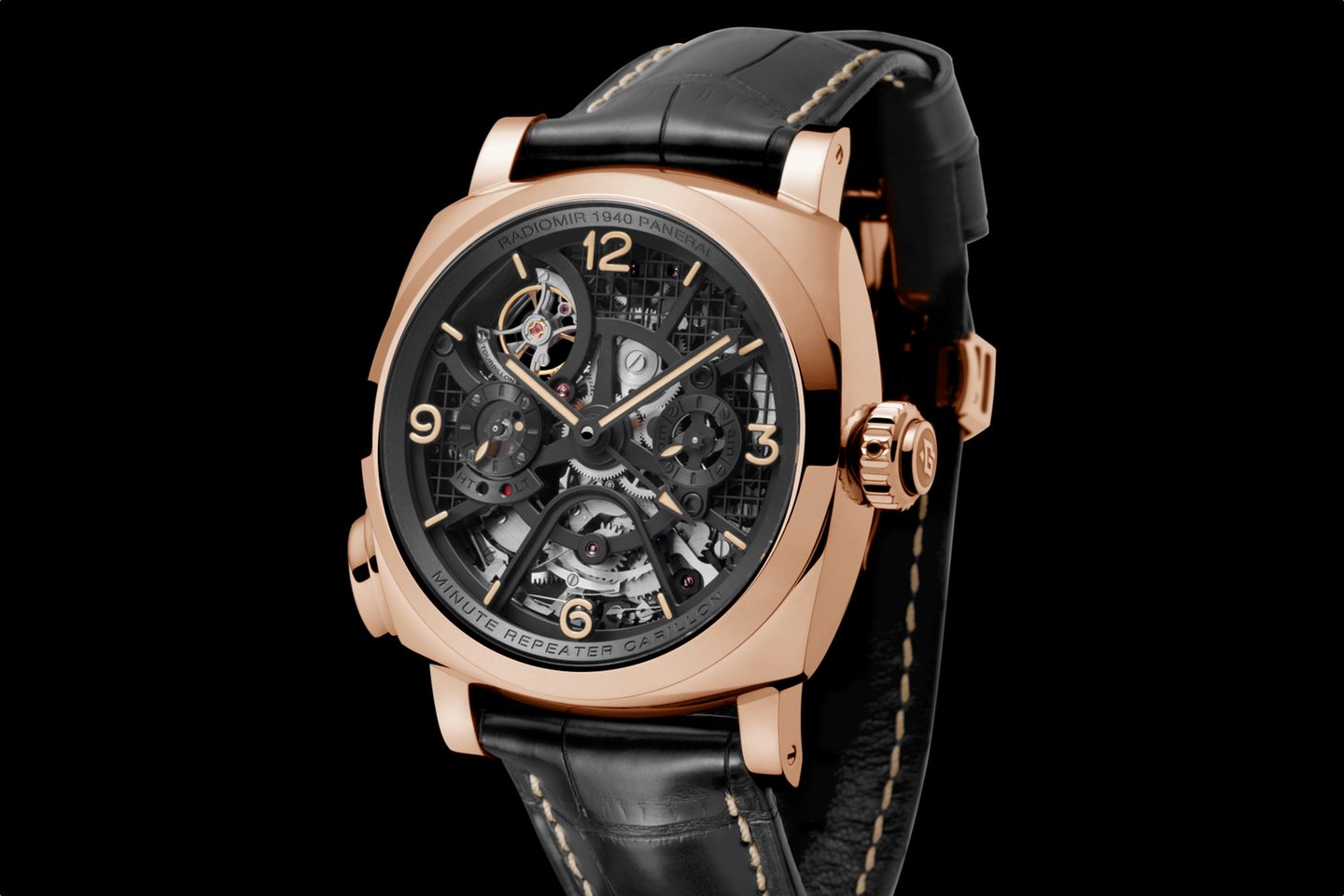This remarkable feature can be activated by an ingenious design that works by slightly rotating the crown until a black indicator dot can be seen on the side of the crown. Once it is in the position where the dot can be can be seen from the front, the wearer can then press the push-piece in the center of the crown, toggling the system between HT/LT with each push. A status indicator at 8 o’clock shows which time zone is currently active. Once the crown is returned to its normal position, so the black dot is not visible from the front of the watch, the chimes can then be activated by the pusher at 8 o’clock.
Early this week, watch brand Panerai unveiled the Radiomir 1940 Minute Repeater Carillon Tourbillon GMT which features the unusual combination of a decimal repeater – and the ability to chime the time for two different time zones.

In addition to the fact that two time zones can be audibly indicated, another unique design element is that there is a pusher instead of a slide to activate the chiming function. Also, unique relative to repeaters is that the chiming is done by three hammers and three gongs (metal tubes around the case that are stacked on top of each other), offering more distinction between the audible time indications than a traditional repeater.
Panerai says, “As is traditional, the first gong is the lowest and identifies the hour while the last and highest indicates individual minutes. The unusual feature is that the second gong sounds triple chimes of an intermediate note, each triple chime corresponding to ten minutes instead of the traditional fifteen.”
This is a decimal repeater, so instead of quarter hours, ten minute intervals are chimed. “An example will help to describe the operation: in an ordinary repeater, the time of 10.28 is usually indicated by ten chimes for the hour, a different chime for the quarter of an hour and thirteen individual chimes for the minutes. In Officine Panerai’s Minute Repeater Carillon, however, the sequence consists of ten chimes for the hour, then two triple chimes (the two ten-minute intervals) and eight single chimes. The system of tens, reducing the number of chimes, makes telling the time easier and quicker, and it also corresponds to the customary way in which time is now indicated by digital watches.”

The sound quality is enhanced by making the case from 18K red gold (which has platinum that helps propagate the sound), and thanks to a special construction which enables the empty spaces inside the case to be optimized.
The dial is skeletonized, and features applied Arabic numerals at 12, 3, 6, and 9, and indices for the other eight hours. Baton shaped hour and minute hands indicate the time, with a large arrow-tipped hand for the second time zone. All of the markers, and hands, including the hand for the am/pm indicator and small seconds hand, are filled with a beige luminescent material. In between the movement and the dial is a black grille, similar to what is seen on the Lo Scienziato Luminor 1950 Tourbillon GMT Titanio that was introduced at SIHH.
Underneath the dial, is hand wound mechanical caliber P.2005/MR, executed entirely by Panerai. The movement features two mainspring barrels, good for 4-days of power reserve (96-hours). An indicator on the back shows the remaining power in the mainspring barrels. In total, there are 633 components, 59 of which are jewels.

Notably, as well as the minute repeater mechanism, the movement, which took four years of research and development to create, also has a unique tourbillon, visible at 11 o’clock on the dial side, and also visible through the sapphire caseback. This patented tourbillon rotates differently than a classic tourbillon. Instead of the balance cage rotating continuously on itself, the Panerai tourbillon cage rotates on an axis which is perpendicular, not parallel, to the balance. Furthermore, the full rotation takes place every 30 seconds, as opposed to the more common 60 second rotation (which is shown by an indicator which rotates in the small seconds counter at 9 o’clock). And according to the manufacture, “the greater speed and the particular arrangement of the mechanism enable it to compensate for any changes of rate very effectively, ensuring a very accurate precision timepiece.”
The Radiomir 1940 Minute Repeater Carillon Tourbillon GMT has a 49 mm diameter case and is water-resistant to 30 meters. Each piece is a special edition made to order, including the client’s choice of strap, as well as an option to pick different hands, and other special features, including the selection of a case material other than red gold. (Ref. PAM00600) $395,000
Final Remarks
As an advocate of chronometry (the science of watchmaking), it is nice to see watchmaking advancements at any level, even if this price point is unattainable for most people. Why? Some of the features of this halo piece could eventually trickle down into more affordable pieces. The way the crown works, for example, could be used to add additional functionality to future watches. And this is why, to me, the advancement of the science of timekeeping, is always a good thing.




